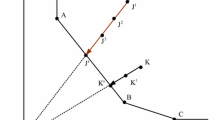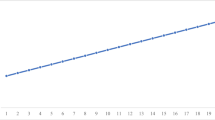Abstract
This paper aims to offer a quantitative contribution to energy-environment policy in Japan in the aftermath of the Fukushima nuclear power accident. Since then, nuclear power energy supply has almost entirely been banned, and consequently, an intensive search for alternative forms of energy supply (ranging from fossil fuels to renewable forms of energy, such as solar or thermal power) has started. There is no clear-cut direction for energy policy, as each option involves costs and CO2 consequences; Japan has even withdrawn from the Kyoto protocol. A balanced energy-environment policy is difficult to achieve in the short term, and therefore, there is an urgent need for a comprehensive efficiency and performance analysis of the Japanese energy sector. A popular standard tool to judge the efficiency or performance of a decision-making unit (DMU) is a data envelopment analysis (DEA). The existence of multiple efficiency-improvement solutions has prompted much criticism in recent years. In the meantime, much progress has been made in extending this approach in several directions. An example is the euclidean distance minimisation (EDM) method, based on a generalised distance function, which serves to improve a DMU’s performance by tracing the most appropriate movement towards the efficiency frontier. The EDM model is able to calculate an optimal input reduction value and an optimal output increase value in order to reach an efficiency score of 1.0, even though in reality this may be hard to achieve for low-efficiency DMUs. In contrast, high-efficiency DMUs might find it easier to reach an efficiency score of 1.0, or in the case of a super-efficiency DEA, a score of above 1.0. This paper aims to present a newly developed adjusted DEA model, emerging from a blend of the EDM and the target-oriented (TO) approach based on a super-efficiency model, for generating an appropriate efficiency-improving projection model. The TO approach specifies a target-efficiency score (TES) for inefficient DMUs. This approach can compute an input reduction value and an output increase value in order to achieve a higher TES. The abovementioned TO-EDM model will be applied to an efficiency analysis of the energy-environment interface for 10 regions in Japan. The focus will be on one input cost criterion (viz. expenditures) and two output performance criteria (viz. electricity generation and CO2 emission). Based on an extensive database, a comparative performance analysis of the 10 Japan regions under consideration will be pursued.










Similar content being viewed by others
References
Anderson, P., & Petersen, N. (1993). A procedure for ranking efficient units in data envelopment analysis. Management Science, 39, 1261–1264.
Charnes, A., Cooper, W. W., & Rhodes, E. (1978). Measuring the efficiency of decision making units. European Journal of Operational Research, 2, 429–444.
Charnes, A., Cooper, W. W., Golany, B., Seiford, L. M., & Stutz, J. (1985). Foundation of data envelopment analysis for Pareto-Koopmans efficient empirical production functions. Journal of Econometrics, 30, 91–107.
Cooper, W. W., Tone, K., & Seiford, L. M. (2006). Introduction to data envelopment analysis and its uses. New York: Springer Science, Business Media.
Frei, F. X., & Harker, P. T. (1999). Projections on to efficient frontiers: theoretical and computational extensions to DEA. Journal of Productivity Analysis, 11(3), 275–300.
Golany, B. (1988). An interactive MOLP procedure for the extension of DEA to effectiveness analysis. Journal of the Operational Research Society, 39, 725–734.
Halme, M., Joro, T., Korhonen, P., Salo, S., & Wallenius, J. (1999). A value efficiency approach to incorporating preference information in data envelopment analysis. Management Science, 45(1), 103–115.
Li, J., Li, J., & Zheng, F. (2014). Unified efficiency measurement of electric power supply companies in China. Sustainability, 6(2), 779–793.
Joro, T., Korhonen, P., & Wallenius, J. (1998). Structural comparison of data envelopment analysis and multiple objective linear programming. Management Science, 44(7), 962–970.
Korhonen, P., & Siljamäki, A. (2002). On the use of value efficiency analysis and some further developments. Journal of Productivity Analysis, 17(1–2), 49–64.
Korhonen, P., Stenfors, S., & Syrjänen, M. (2003). Multiple objective approach as an alternative to radial projection in DEA. Journal of Productivity Analysis, 20(20), 305–321.
Lins, M. P. E., Angulo-Meza, L., & Moreira da Silva, A. C. (2004). A multi-objective approach to determine alternative targets in data envelopment analysis. Journal of Operational Research, 55, 1090–1101.
Martínez, P. (2011). Energy efficiency development in German and Colombian non-energy-intensive sectors: a non-parametric analysis. Energy Efficiency, 4(1), 115–131.
Scheel, H. (2001). Undesirable outputs in efficiency valuations. European Journal of Operational Research, 132(2), 400–410.
Seiford, L A (2005). Cyber-bibliography for data envelopment analysis (1978–2005).
Seiford, L., & Zhu, J. (2002). Modeling undesirable factors in efficiency evaluation. European Journal of Operational Research, 142(1), 16–20.
Silva, M., Castro, P., & Thanassoulis, E. (2003). Finding closest targets in non-oriented DEA models: the case of convex and non-convex technologies. Journal of Productivity Analysis, 19, 251–269.
Suzuki, S., Nijkamp, P., Rietveld, P., & Pels, E. (2010). A distance friction minimization approach in data envelopment analysis: a comparative study on airport efficiency. European Journal of Operational Research, 207, 1104–1115.
Thanassoulis, E., & Dyson, R. G. (1992). Estimating preferred target input–output levels using data envelopment analysis. European Journal of Operational Research, 56, 80–97.
Tone, K. (2001). A slack-based measure of efficiency in data envelopment analysis. European Journal of Operational Research, 130, 604–613.
Washio, S., Yamada, S., Tanaka, T., & Tanino, T. (2012). Improvements by analyzing the efficient frontier in DEA. European Journal of Operational Research, 217, 173–184.
Wu, A., Cao, Y., & Liu, B. (2013). Energy efficiency evaluation for regions in China: an application of DEA and Malmquist indices. Energy Efficiency. in print.
Yang, X., & Morita, H. (2013). Efficiency improvement from multiple perspectives: an application to Japanese banking industry. Omega, 41(3), 501–640.
Author information
Authors and Affiliations
Corresponding author
Additional information
Piet Rietveld passed away on November 1, 2013.
Highlights
• The Fukushima incident hampers the achievement of CO2 emission targets in Japan
• The DEA method is extended to assist target setting for energy-environment policy
• The assessment method is applied to sustainable energy policies for 10 regions in Japan
Appendix
Appendix
A1. Outline of DEA and efficiency improvement projection
The standard Charnes et al. (1978) model (abbreviated hereafter as the CCR-input model) for a given DMU j (j = 1,…, J) to be evaluated in any trial o (where o ranges over 1, 2, …, J) may be represented as the following fractional programming (FP o ) problem:
where θ represents an objective variable function (efficiency score); x mj is the volume of input m (m = 1,…, M) for DMU j (j = 1,…, J); y sj is the output s (s = 1,…, S) of DMU j ; and v m and u s are the weights given to input m and output s, respectively. Model (A.1) is often called an input-oriented CCR model, while its reciprocal (i.e. an interchange of the numerator and denominator in the objective function (A.1) with a specification as a minimisation problem under an appropriate adjustment of the constraints) is usually known as an output-oriented CCR model. Model (A.1) is obviously a fractional programming model, which may be solved stepwise by first assigning an arbitrary value to the denominator in (A.1) and then maximising the numerator (see also Cooper et al. 2006).
The improvement projection \( \left({\widehat{x}}_o,{\widehat{y}}_o\right) \) can now be defined in (A.2) and (A.3) as the following:
These equations indicate that the efficiency of (x o , y o ) for DMU o can be improved if the input values are reduced radially by the ratio θ * and the input excesses s −* are eliminated (see Fig. 11).
The original DEA models presented in the literature have focused on a uniform input reduction or on a uniform output increase in the efficiency improvement projections, as shown in Fig. 11 (θ* = OC′/OC).
A2. A super-efficiency model
In a standard DEA model, all efficient DMUs get the score 1, so that there is no way to differentiate between them. This has led to focused research to discriminate between efficient DMUs, in order to arrive at a ranking, or even a numerical rating of these efficient DMUs, without affecting the results for the non-efficiency. In particular, Anderson & Petersen (1993) developed a radial super-efficiency model. In general, a super-efficiency model aims to identify the relative importance of each individual efficient DMU, by designing and measuring a score for its “degree of influence”, if this efficient DMU is omitted from the efficiency frontier (or production possibility set). If this elimination really matters (i.e. if the distance from this DMU to the remaining efficiency frontier is large) and, thus, the firm concerned has a high degree of influence and outperforms the other DMUs, it gets a high score (and is thus super-efficient). Therefore, for each individual DMU, a new distance result is obtained, which leads to a new ranking or even a rating of all the original efficient DMUs.
Anderson & Petersen (1993) have developed the super-efficiency model based on a radial projection (including a CCR model) to arrive at a ranking of all efficient DMUs. The efficiency scores from a super-efficiency model are thus obtained by eliminating the data on the DMU o to be evaluated from the solution set. For the input model, this can then result in values, which may be regarded, according to the DMU o , as a state of super-efficiency. These values are then used to rank the DMUs, and consequently, efficient DMUs may then obtain an efficiency score above 1.000.
The super-efficiency model based on a CCR-I model can now be written as follows:
where e is a unit vector (1,…, 1), representing a utility factor for all elements.
Rights and permissions
About this article
Cite this article
Suzuki, S., Nijkamp, P. & Rietveld, P. A target-oriented data envelopment analysis for energy-environment efficiency improvement in Japan. Energy Efficiency 8, 433–446 (2015). https://doi.org/10.1007/s12053-014-9297-z
Received:
Accepted:
Published:
Issue Date:
DOI: https://doi.org/10.1007/s12053-014-9297-z





